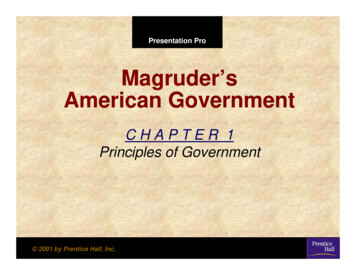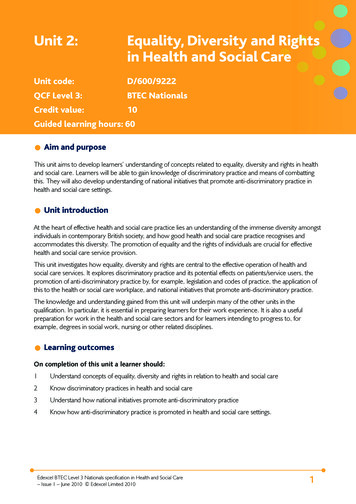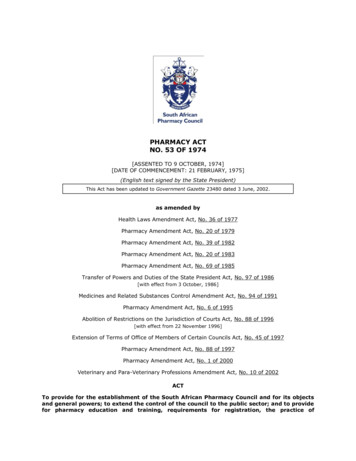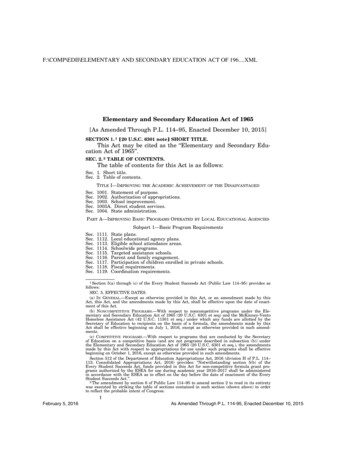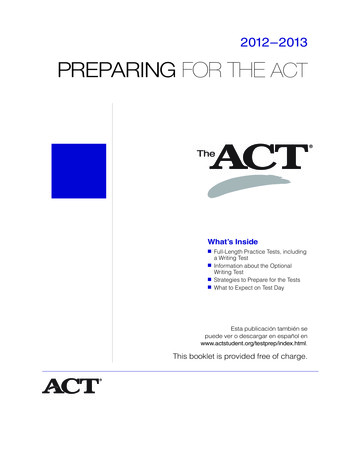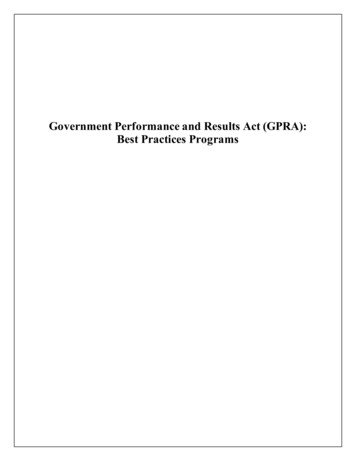
Transcription
Government Performance and Results Act (GPRA):Best Practices Programs
Frequently Asked Questions (FAQs)Government Performance and Results Act1. What are the Government Performance and Results Act (GPRA) of 1993 and the GPRAModernization Act of 2010?GPRA is a public law passed by Congress in 1993. Congress enacted GPRA to improve stewardshipwithin the federal government and to link resources and management decisions with programperformance.The GPRA Modernization Act updated several aspects of GPRA. It emphasizes priority setting,cross-organizational collaboration to achieve common goals, and the use and analysis of goals andmeasures to improve the outcomes of federally funded programs. For more information, go to theSubstance Abuse and Mental Health Services Administration’s (SAMHSA’s) GPRA MeasurementTools webpage.2. Do we have to comply with GPRA?All SAMHSA discretionary programs—both Best Practices and Discretionary Services—mustcomply with GPRA. In their grant applications, prospective grantees should state the procedures theywill put in place to ensure both compliance with GPRA and the collection of data elements at baselineand follow-up.Best Practices Training1. Can we receive training on collecting and entering Best Practices data into SAMHSA’sPerformance Accountability and Reporting System (SPARS)?Yes. A recorded Data Collection Tools Overview for Technology Transfer Centers training about thenew Best Practices tools is available on SPARS. This recording is intended for all Best Practicesgrantees. To access the recorded training, click the Training tab on the SPARS home page andfollow these steps: On the Training page, under the Course categories menu, select Archived SPARS Webinars AllCenters.Continued on Next PageOctober 2021Page 2v2.0
Browse or search the training list for Data Collection Tools Overview for Technology TransferCenters and click the title, which takes you to the Enrollment options page for this course. Click the blue Enroll Me button and submit the requested information. This takes you to thespecific course page. Click the link to View webinar recording.Best Practices Tools1. Why were the Best Practices tools developed?Data collected using these tools are vital to support SAMHSA’s compliance with GPRA reportingrequirements and to inform future development of knowledge dissemination activities. Best Practicesdata assist SAMHSA in documenting the numbers and types of participants in Best Practices events, describing the extent to which participants report improvement in their professional development,and determining which method is most effective in disseminating knowledge to various audiences.2. When do we start using the new Best Practices tools?You must complete and submit all post-event and follow-up data from the older tools into SPARS bySeptember 30, 2019. All Best Practices (Non–Technology Transfer Center [TTC]) grantees shouldbegin using the tools on October 1, 2019, and can enter data from the new tools in SPARS startingNovember 25, 2019.October 2021Page 3v2.0
3. Where are the Best Practices tools located in SPARS?The Best Practices tools can be downloaded from the Data Collection Tool Resources page located onthe SPARS home page. Once in Data Collection Tool Resources, Best Practices (Non-TTC) grantsshould select CSAT Best Practices (Non-TTC) from the Data Entry Type filter option on the left sideof the page.The Best Practices tools can also be downloaded from the Resource Library page, which is located onthe SPARS home page. Once in the Resource Library, select the CSAT – Center for Substance AbuseTreatment menu. From this menu, select Best Practices Best Practices (Non-TTC) DataCollection Tools to locate and download the tools.4. Where are the meeting, training, and technical assistance event forms located in SPARS?SAMHSA no longer uses the meeting, training, and technical assistance event forms. Data from theseforms cannot be entered in SPARS after September 30, 2019. SAMHSA no longer requires granteesto specify what type of event—meeting, training, or technical assistance—the Best Practices programimplemented or sponsored.October 2021Page 4v2.0
5. Can we continue to enter meetings, trainings, and technical assistance events into SPARS usingthe old tools?Grantees can enter data into SPARS using the old meeting, training, and technical assistance forms upuntil September 30, 2019. After September 30, 2019, Best Practices grantees will only be able toenter data using the new Best Practices tools.6. Which grantees will use the new Best Practices tools?All Best Practices grantees will use the new Best Practices tools.7. How many Best Practices tools are there, and when do we use each one?There are three Best Practices tools: Best Practices Event Description FormBest Practices grantees will complete this form for each event implemented or sponsored.Information collected on this form includes the event code, the number of participants, and thenumber of participants consenting to follow-up. Grantees enter the information from this form inSPARS. Best Practices Post-Event FormBest Practices grantees will ask participants to complete this satisfaction survey at the end of theevent. Participants will include their participant ID number in the survey form and respond todemographic questions and questions that measure satisfaction with the event. Once the form iscomplete, the participant will return the survey to the event administrator. Grantees enter theinformation from this form in SPARS. Best Practices Follow-Up FormBest Practices grantees will ask participants to complete this follow-up survey 30 days after theevent. Participants will include their participant ID number in the form and respond to questionsthat measure continued satisfaction with the event. Once the form is complete, the participant willreturn the follow-up survey to the grantee. Grantees enter the information from this form inSPARS.8. Do we provide follow-up forms to participants if the event was shorter than 3 hours?No. Grantees only complete follow-up forms for events lasting 3 hours or longer.9. How is the participant ID system developed?Each individual site develops its own participant ID system. Each event participant should have aunique participant ID. It is very important that the program tracks participant IDs given on post-eventforms. To count as a valid follow-up, the ID number on the follow-up form must be the same as theOctober 2021Page 5v2.0
ID number on the post-event form. In other words, a follow-up form only counts in the SPARSsystem if there is a matching participant ID for a post-event form.10. Can Best Practices grantees change the wording of the tools?No. Grantees cannot change the wording of the tools.11. Do we have to administer the tool at every event?Grantees must administer the tool for each event implemented or sponsored. The program decideswhether an event is designated as a GPRA event. Grantees who are unsure whether the event countstoward their GPRA event target number should contact their government project officer (GPO).12. How do we handle a series of events on the same topic?For a series of events on the same topic, grantees should consider the series as one event andadminister the Best Practices tool at the end of the series.13. What is the targeted follow-up rate?The targeted follow-up rate set by the Office of Management and Budget is 80 percent.14. What if participants send back follow-up surveys more than 30 days after the event?Programs have a 60-day window after the event anniversary date to collect and enter follow-up data.Programs may accept and enter data falling within this window.Best Practices Data Entry1. Where do we enter our Best Practices data in SPARS?All Best Practices grantees will submit Best Practices data under the CSAT Data Entry page inSPARS. To access this page, click the Data Entry & Reports tab located on the SPARS home page,then click CSAT Users CSAT Data Entry.Continued on Next PageOctober 2021Page 6v2.0
2. Can anyone enter Best Practices data into SPARS?No. Every person who will be entering data in SPARS must have a username and password to accessSPARS. To request or disable usernames and passwords, project directors should contact the SPARSHelp Desk at 1-800-685-7623 or SPARSHelpDesk@mathematica-mpr.com.3. How often should we enter our data?Grantees must enter all data in SPARS as close to the actual time of the event as possible. SAMHSArecommends entering data within 1 business day and no later than 7 business days after completing orreceiving Best Practices forms.4. Can we delete Best Practices data?No. Grantees cannot delete Best Practices data that they have entered in SPARS. If staff need toremove incorrect data from SPARS, grantees can contact the SPARS Help Desk to have dataremoved. Please contact the SPARS Help Desk at 1-800-685-7623 orSPARSHelpDesk@mathematica-mpr.com.5. How do we report GPRA data to SAMHSA and our GPO?SPARS automatically submits to SAMHSA the data entered by grantees, thus eliminating the needfor you to make a separate, manual submission of data to SAMHSA or your GPO.6. Are Best Practices grantees responsible for submitting data for the first quarter of their grant?Yes. Grantees who do not expect to have events during a quarter must discuss this with theirSAMHSA GPO.October 2021Page 7v2.0
7. Can we edit our Best Practices data?For Best Practices (Non-TTC) grantees, data using the old meeting, training, and technical assistanceforms can be edited up until November 24, 2019. After November 24, 2019, you can only edit datathat were submitted via the new Best Practices tools.8. Can we download our Best Practices data?Yes. You can download Best Practices data under the CSAT Data Download page in SPARS. Toaccess this page, click the Data Entry & Reports tab located on the SPARS home page, then clickCSAT Users CSAT Data Download.9. Can we upload our Best Practices data?No. Best Practices grantees cannot upload their data into SPARS.10. Are Best Practices reports available in SPARS?Yes. Best Practices reports are available in SPARS. The Best Practices reports include a 30-DayFollow-Up Rate Report and a Coverage Report. To access the reports, click the Data Entry & Reportstab on the SPARS home page. Click the CSAT Users button, then click the CSAT Reportssubcategory.Continued on Next PageOctober 2021Page 8v2.0
If you are an existing Best Practices grantee and were using the old forms to collect participant data,your old reports will remain in SPARS so that you can report previously collected data. The oldreports include Frequency Distribution, Evaluation Summary, Grantee Cost, and GranteeDelinquency.11. Whom do we contact if we have additional questions?For all SPARS-related questions, contact the SPARS Help Desk at 1-800-685-7623 orSPARSHelpDesk@mathematica-mpr.com. For any clinical or program-specific questions, pleasecontact your GPO.October 2021Page 9v2.0
All SAMHSA discretionary programs —both Best Practices and Discretionary Services —must comply with GPRA. In their grant applications, prospective grantees should state the procedures they . Please contact the SPARS Help Desk at 1-800-685-7623 or . SPARSHelpDesk@mathematica-mpr.com. 5. How do we report GPRA data to SAMHSA and our GPO?



